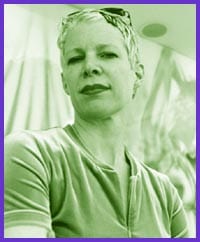“I came of age as a lesbian by going to strip clubs in Vancouver and Toronto,” says professor Becki Ross.
Now Ross – an acclaimed lesbian historian – is getting paid for that interest.
Last year, Ross received a $50,000 federal grant to pursue her interest in the social history of striptease and burlesque in Vancouver.
“What resulted was a media feeding frenzy,” says Ross. “Questions were raised about the validity of my research into a topic that was undeserving of attention for many, and disgusting for some.”
The Federation Of Canadian Tax Payers called the research a “joke” and a waste of dough, while individuals sent Ross’s team (she’d hired two research assistants) hate mail.
“A large aim of my research is to challenge the stigma attached to women who dance to make a living,” says Ross.
“The outcry against it shows that stereotypes about these women being nymphomaniacs, uneducated, victims, diseased, perverts, immoral and otherwise unemployable are still prevalent to this day…. That’s not my understanding of the business and the women who work in it.”
Key to Ross’s study is exploring the connection between queers and erotic performance. According to Ross, earlier studies of strippers in the post-war era have reported disproportionate numbers of homosexuals.
“We know that many queers were insiders as dancers, club owners, clothing designers, make-up artists, choreographers, wig makers and patrons. This includes MTF transgendered and transexuals, lesbians and gay men.”
In general, Ross found that stripping was a femme occupation, while butch women featured as patrons. Transgendered and transexual females were also frequently dancers, while gay men tended to gravitate towards wig making, choreography and costume design.
Then there were the renegades who broke all these rules like “Klute,” a lesbian dancer who flaunted her butchness on stage.
“Most [of the homos interviewed] talked about the business in very affectionate terms. There were definitely struggles for them and worries over their personal safety [because of potential assaults by patrons]. But they felt a strong sense of belonging to a theatrical community where it was easier to be queer than in the world at large.
“The presence of queers at all levels upsets the image of striptease as a strictly heterosexual business where straight women perform to entertain straight men,” says Ross.
Ross maintains that stripping is integral to understanding the cultural past of urban Canada. From the 1940s to the ’70s, erotic dance was performed in Vancouver’s clubs, pubs, house parties, after-hours bars and at the Pacific National Exhibition.
“Stripping,” says Ross, “is a significant and misunderstood part of Canadian history.”
If you were involved in the female striptease scene in Vancouver from 1945 to ’80, you can reach Ross at The Striptease Project at (604) 822-4389 or e-mail her at becki@interchange.ubc.ca. TS/TG women are encouraged to participate.

 Why you can trust Xtra
Why you can trust Xtra


